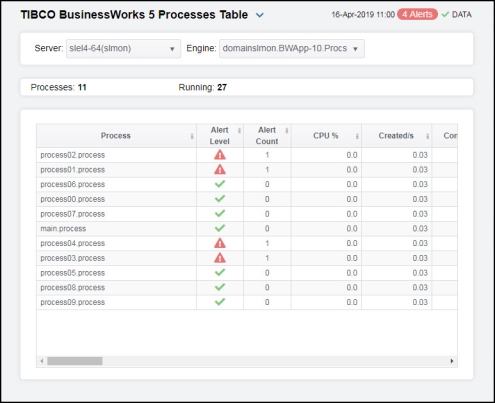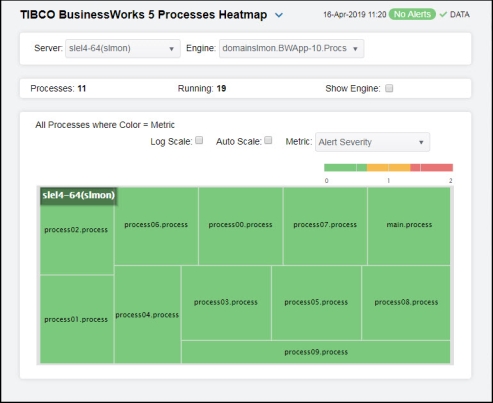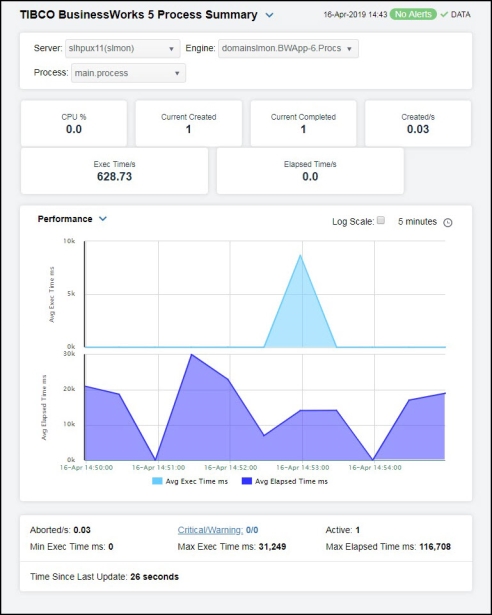BW5 Processes
These displays present performance metrics and alert status for all BW5 processes. Clicking BW5 Processes from the left/navigation menu opens the TIBCO BusinessWorks 5 Processes Table display, where each row in the table displays all available metrics from the Hawk microagent for a process. The options available under BW5 Processes are:
| • | All Processes Heatmap: Opens the TIBCO BusinessWorks 5 Processes Heatmap , which shows process execution metrics for all BW Engines. |
| • | BW5 Process Summary: Opens the TIBCO BusinessWorks 5 Process Summary display, which shows historical and current metrics for a single process, including average execution times and execution counts. |
TIBCO BusinessWorks 5 Processes Table
Select a server and engine from the drop-down menus. Each row in the table is a different process. The table displays all metrics available from the Hawk microagent for a process. (Refer to documentation for TIBCO BusinessWorks Administration, see Appendix A: TIBCO Hawk Microagent Methods).
Click a column header to sort column data in ascending or descending order. Double-click on a table row to drill-down to the TIBCO BusinessWorks 5 Process Summary display and view metrics for that particular process. Toggle between the commonly accessed Table and Heatmap displays by clicking the drop down list on the display title.

|
Filter By: The display might include these filtering options: |
||||
|
|
Server: |
Select the server for which you want to view data in the display. |
||
|
|
Engine: |
Select the engine for which you want to view data in the display. |
||
|
Processes |
The number of processes listed in the table. |
|||
|
Table: |
||||
|
|
Process |
The name of the process. |
||
|
|
Alert Level |
The most critical alert state for alerts in the row:
|
||
|
|
Alert Count |
Number of current alerts |
||
|
|
Total CPU |
Total CPU usage in percent. |
||
|
|
Created/s |
Change in Created per second. |
||
|
|
Completed/s |
Change in Completed per second. |
||
|
|
Created |
Number of process instances created for this process definition. |
||
|
|
Completed |
Number of process instances successfully completed. |
||
|
|
Total Exec Time ms |
Total execution time (in milliseconds) for all successfully completed process instances. |
||
|
|
Exec Time/s |
Delta execution time per second. |
||
|
|
Current Total Execs |
Execution time accumulated during the current polling period. |
||
|
|
Min Exec Time ms |
Execution time (in milliseconds) of the process instance that has completed in the shortest amount of execution time. |
||
|
|
Max Exec Time ms |
Execution time (in milliseconds) of the process instance that has completed in the longest amount of execution time. |
||
|
|
Avg Exec Time ms |
Average execution time (in milliseconds) for all successfully completed process instances. |
||
|
|
Most Recent Exec Time ms |
Execution time (in milliseconds) of the most recently completed process instance. |
||
|
|
Total Elapsed Time ms |
Total elapsed time (in milliseconds) for all successfully completed process instances. |
||
|
|
Current Elapsed ms |
Elapsed time accumulated during the current polling period. |
||
|
|
Elapsed Time/s |
Delta elapsed time per second. |
||
|
|
Min Elapsed Time ms |
Elapsed clock time (in milliseconds) of the process instance that has completed in the shortest amount of elapsed time. |
||
|
|
Max Elapsed Time ms |
Elapsed clock time (in milliseconds) of the process instance that has completed in the longest amount of elapsed time. |
||
|
|
Avg Elapsed Time ms |
Average elapsed clock time (in milliseconds) for all successfully completed process instances. |
||
|
|
Most Recent Elapsed Time |
Elapsed clock time (in milliseconds) of the most recently completed process instance. |
||
|
|
Aborted |
Number of times process instances have been aborted. |
||
|
|
Current Aborted |
Change in Aborted this update. |
||
|
|
Aborted/s |
Change in Aborted per second. |
||
|
|
Queued |
Number of times process instances have been queued for execution. |
||
|
|
Current Queued |
Change in Queued this update. |
||
|
|
Queued/s |
Change in Queued per second. |
||
|
|
Suspended |
Number of times process instances have been suspended. |
||
|
|
Current Suspended |
Change in Suspended this update. |
||
|
|
Suspended/s |
Change in Suspended per second. |
||
|
|
Checkpointed |
Number of times process instances have executed a checkpoint. |
||
|
|
Current Checkpointed |
Change in Checkpointed this update. |
||
|
|
Checkpointed/s |
Change in Checkpointed per second. |
||
|
|
Swapped |
Number of times process instances have been swapped to disk. |
||
|
|
Current Swapped |
Change in Swapped this update. |
||
|
|
Swapped/s |
Change in Swapped per second. |
||
|
|
Time Since Last Update |
Time since the last update. |
||
|
|
Domain |
Name of TIBCO Domain. |
||
|
|
Starter |
Name of the process starter for the process. |
||
|
|
Micro Agent Instance |
Unique ID of the microagent reporting the metrics. |
||
|
|
Count Since Reset |
Number of process instances that have completed since the last reset of the statistics. |
||
|
|
Source |
Name of RTView Data Server sending this data (or localhost). |
||
|
|
Time Stamp |
Time of last update. |
||
TIBCO BusinessWorks 5 Processes Heatmap
Clicking All Processes Heatmap in the left/navigation menu opens the TIBCO BW5 Processes Heatmap, which allows you to view the status and alerts of all BW5 processes for all engines or for a specific engine. Use the Metric drop-down menu to view processes in the heatmap by the Alert Severity, Alert Count, CPU Used Percentage, Completed Processes, Active Processes, Aborted Processes, Suspended Processes, Execution Time per second, Created per second, Aborted per second, Suspended per second, Most Recent Execution Time, Average Execution Time, Most Recent Elapsed Time, and Average Elapsed Time.
The heatmap is organized by host with each rectangle representing a process. Move your mouse over a node to display current metrics. Click on a node to drill-down to the TIBCO BusinessWorks 5 Process Summary display to view specific metrics about process behavior over a specified period of time and determine which activity in the process may be causing the bottleneck.

|
Filter By: The display might include these filtering options: |
||||
|
|
Server: |
Select the server for which you want to view data in the display. |
||
|
|
Engine: |
Select the engine for which you want to view data in the display. |
||
|
|
Processes |
The total number of processes in the display. |
||
|
|
Running |
Number of processes currently running. |
||
|
|
Show Engine |
Select this check box to display the names of the engines above their respective rectangles in the heatmap. |
||
|
|
Log Scale |
Select to enable a logarithmic scale. Use Log Scale to see usage correlations for data with a wide range of values. For example, if a minority of your data is on a scale of tens, and a majority of your data is on a scale of thousands, the minority of your data is typically not visible in non-log scale graphs. Log Scale makes data on both scales visible by applying logarithmic values rather than actual values to the data. |
||
|
|
Auto Scale |
Select to enable auto-scaling. When auto-scaling is activated, the color gradient bar's maximum range displays the highest value. NOTE: Some metrics auto-scale automatically, even when Auto Scale is not selected. |
||
|
|
Metric |
Select the metric driving the heatmap display. The default is Alert Severity. Each Metric has a color gradient bar that maps values to colors. The heatmap organizes the servers by host, where each rectangle represents a process. Mouse-over any rectangle to display the current values of the metrics for the process. Click on a rectangle to drill-down to the associated TIBCO BusinessWorks 5 Process Summary display for a detailed view of metrics for that particular process.
|
||
|
|
|
Alert Severity |
The maximum level of alerts in the heatmap rectangle. Values range from 0 - 2, as indicated in the color gradient
|
|
|
|
|
Alert Count |
The total number of critical and warning alerts in the heatmap rectangle. The color gradient |
|
|
|
|
CPU Used % |
The percent (%) CPU used in the heatmap rectangle. The color gradient |
|
|
|
|
Completed |
The total number of completed processes in the heatmap rectangle. The color gradient |
|
|
|
|
Active |
The total number of active processes in the heatmap rectangle. The color gradient |
|
|
|
|
Aborted |
The total number of aborted processes in the heatmap rectangle. The color gradient |
|
|
|
|
Suspended |
The total number of suspended processes in the heatmap rectangle. The color gradient |
|
|
|
|
Exec Time/s |
The number of processes executed per second in the heatmap rectangle. The color gradient |
|
|
|
|
Created/s |
The number of processes created per second in the heatmap rectangle. The color gradient |
|
|
|
|
Aborted/s |
The number of aborted processes per second in the heatmap rectangle. The color gradient |
|
|
|
|
Suspended /s |
The number of suspended processes per second in the heatmap rectangle. The color gradient |
|
|
|
|
Most Recent Exec Time |
The execution time for the most recently executed process in the heatmap rectangle. The color gradient |
|
|
|
|
Average Exec Time |
The average execution time for all processes in the heatmap rectangle, calculated by dividing the delta execution time for the interval by the delta completed, or the number of process instances that completed in the interval. The color gradient |
|
|
|
|
Most Recent Elapsed Time |
The elapsed time for the most recently executed process in the heatmap rectangle. The color gradient |
|
|
|
|
Average Elapsed Time |
The average elapsed time for all processes in the heatmap rectangle, calculated by dividing the delta elapsed time for the interval by the delta completed, or the number of process instances that completed in the interval. The color gradient |
|
TIBCO BusinessWorks 5 Process Summary
Clicking BW5 Process Summary in the left/navigation menu opens the TIBCO BusinessWorks 5 Process Summary display, which allows you to track utilization and performance metrics for specific BW5 processes. You can select a server, engine, and process from the drop-down menus. Clicking on the information boxes at the top of the display takes you to the TIBCO BusinessWorks 5 Processes Table display, where you can view additional data on processes.
There are two options in the trend graph: Utilization and Performance. In the Utilization option on the trend graph, you can view trend data for the rate of created processes and CPU percentage over a selected time range. In the Performance option on the trend graph, you can view trend data for used average execution time and average elapsed time over a selected time range.
Clicking the Critical/Warning link at the bottom of the display opens the Alerts Table by Component display.

|
Filter By: The display might include these filtering options: |
||||
|
|
Server: |
Select the server for which you want to view data. |
||
|
|
Engine: |
Select the engine for which you want to view data. |
||
|
Fields and Data |
||||
|
|
CPU % |
The percentage of CPU used by the process. |
||
|
|
Current Created |
The number of processes created since the last data update. |
||
|
|
Current Completed |
The number of completed processes since the last data update. |
||
|
|
Created/s |
The rate of processes created, per second. |
||
|
|
Exec Time/s |
The rate of process execution time, per second. |
||
|
|
Elapsed Time/s |
The rate of elapsed time, per second, for the process. |
||
|
Trend Graphs |
Utilization CPU % -- Traces the CPU utilization percentage. Created Procs/s -- Traces the number of created processes per second. Performance Avg Exec Time ms -- Traces the average time taken to execute processes, in milliseconds. Avg Elapsed Time ms -- Traces the average elapsed time for processes, in milliseconds. |
|||
|
|
|
Log Scale |
Select to enable a logarithmic scale. Use Log Scale to see usage correlations for data with a wide range of values. For example, if a minority of your data is on a scale of tens, and a majority of your data is on a scale of thousands, the minority of your data is typically not visible in non-log scale graphs. Log Scale makes data on both scales visible by applying logarithmic values rather than actual values to the data. |
|
|
|
|
Time Settings |
Select a time range from the drop down menu varying from 5 Minutes to Last 7 Days. By default, the time range end point is the current time.
To change the time range, deselect the now toggle, which displays some additional date fields. You can click the left and right arrow buttons to decrease the end time by one time period (the time selected in the Time range drop down) per click, or you can choose the date and time from the associated calendar and clock icons. You can also enter the date and time in the text field using the following format: MMM dd, YYYY HH:MM:ss. For example, Aug 21, 2018 12:24 PM. Click the now toggle to reset the time range end point to the current time.
|
|
|
Abprted/s |
The rate of aborted processes. |
|||
|
Min Exec Time ms |
Shortest execution time of any process instance, in milliseconds. |
|||
|
Critical/Warning |
The number of critical and warning alerts. |
|||
|
Max Exec Time ms |
Longest execution time of any process instance, in milliseconds. |
|||
|
Active |
The number of active processes. |
|||
|
Max Elapsed Time ms |
Longest elapsed time of any process instance, in milliseconds. |
|||
|
Time Since Last Update |
Time since the last update to file of statistics. |
|||





















